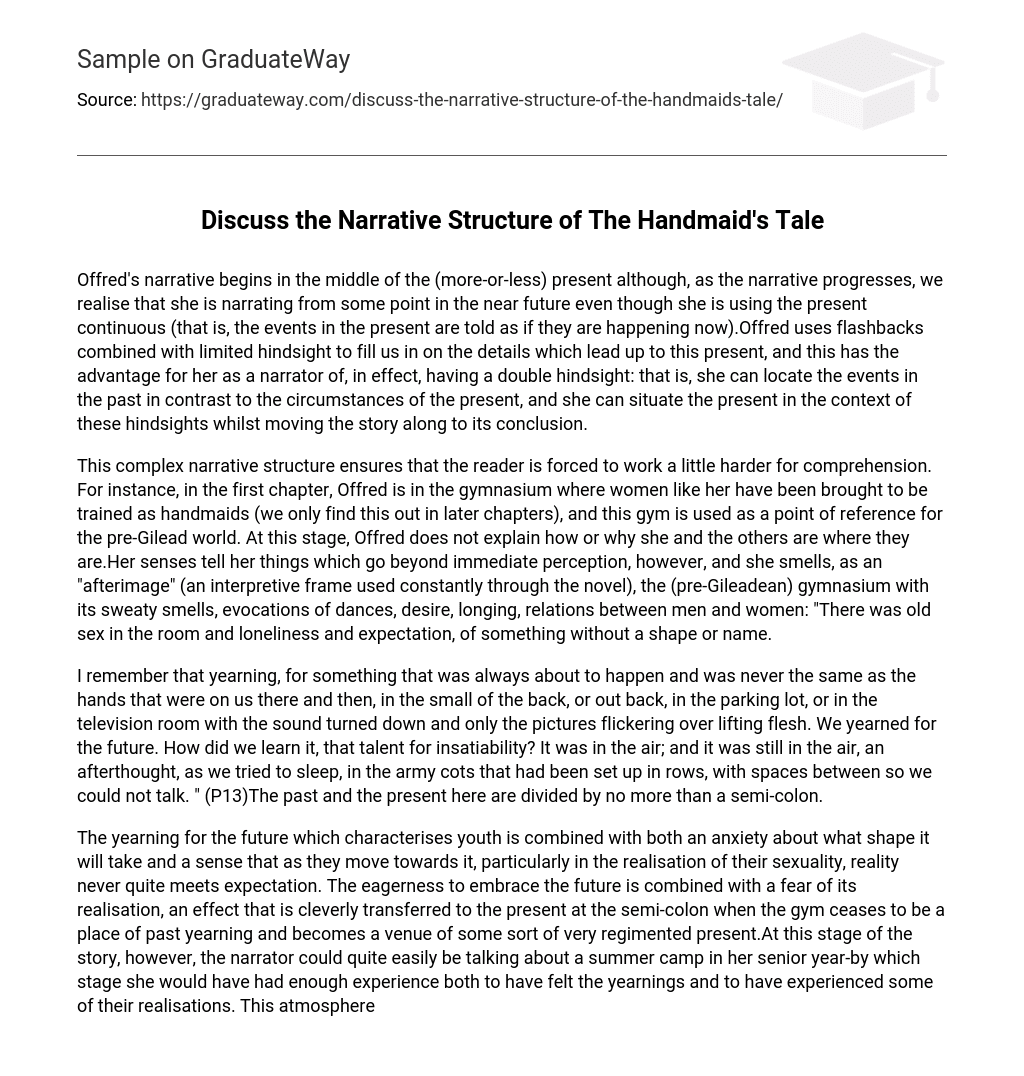Offred’s narrative begins in the middle of the (more-or-less) present although, as the narrative progresses, we realise that she is narrating from some point in the near future even though she is using the present continuous (that is, the events in the present are told as if they are happening now).Offred uses flashbacks combined with limited hindsight to fill us in on the details which lead up to this present, and this has the advantage for her as a narrator of, in effect, having a double hindsight: that is, she can locate the events in the past in contrast to the circumstances of the present, and she can situate the present in the context of these hindsights whilst moving the story along to its conclusion.
This complex narrative structure ensures that the reader is forced to work a little harder for comprehension. For instance, in the first chapter, Offred is in the gymnasium where women like her have been brought to be trained as handmaids (we only find this out in later chapters), and this gym is used as a point of reference for the pre-Gilead world. At this stage, Offred does not explain how or why she and the others are where they are.Her senses tell her things which go beyond immediate perception, however, and she smells, as an “afterimage” (an interpretive frame used constantly through the novel), the (pre-Gileadean) gymnasium with its sweaty smells, evocations of dances, desire, longing, relations between men and women: “There was old sex in the room and loneliness and expectation, of something without a shape or name.
I remember that yearning, for something that was always about to happen and was never the same as the hands that were on us there and then, in the small of the back, or out back, in the parking lot, or in the television room with the sound turned down and only the pictures flickering over lifting flesh. We yearned for the future. How did we learn it, that talent for insatiability? It was in the air; and it was still in the air, an afterthought, as we tried to sleep, in the army cots that had been set up in rows, with spaces between so we could not talk. ” (P13)The past and the present here are divided by no more than a semi-colon.
The yearning for the future which characterises youth is combined with both an anxiety about what shape it will take and a sense that as they move towards it, particularly in the realisation of their sexuality, reality never quite meets expectation. The eagerness to embrace the future is combined with a fear of its realisation, an effect that is cleverly transferred to the present at the semi-colon when the gym ceases to be a place of past yearning and becomes a venue of some sort of very regimented present.At this stage of the story, however, the narrator could quite easily be talking about a summer camp in her senior year-by which stage she would have had enough experience both to have felt the yearnings and to have experienced some of their realisations. This atmosphere changes when the lights go out, and Aunt Sara and Aunt Elizabeth start to patrol with “electric cattle prods” (P14).
Obviously, we now realise, the inhabitants of the gym are prisoners of some sort.This pattern of creating impressions which are more-or-less familiar, and then undercutting them, continues throughout Offred’s narrative and serves to reinforce the similarities and differences between the world of the reader and the dystopic world of Gilead. Not everything is controlled, however, for Offred’s yearning for the past and for human contact comes out in her memories, her desire to talk to the guards (“If only we could talk to [the guards].Something could be exchanged, we thought, some deal made, some trade-off, we still had our bodies.
That was our fantasy” P14), and in her disobedience (the women in the gym talk to each other by learning to lip-read and whisper). In the space of the first two pages of the novel, then, Offred has established the complex narrative structure which will characterise the rest of the novel-an account of her present situation, mixed with nostalgic hindsight, tempered by an anxiety for the future.Offred characterises the conflation of the past and the present as something of a “palimpsest of unheard sound” (a palimpsest is writing material or printing blocks on which the original writing has been effaced to make way for a second writing, or a document turned and written on the reverse side). This image is a powerful one: it suggests, on the one hand, that when we read, as she “reads” the past, we know that the words and images have been “written” with some “meaning” attached; on the other, it suggests that the meanings produced in the act of reading are a function of the present.
In other words, the image of the palimpsest suggests that this is exactly what the narrator will be doing in constructing her narrative-producing a reading of both events in the present and (her memory of) the past, memories which remain only as traces over which she writes her own meaning/story. The palimpsest suggests the doubly fictional nature of the tale-the narrative stance she adopts, as mediator of her own experiences is nothing more than a convenient fiction.





